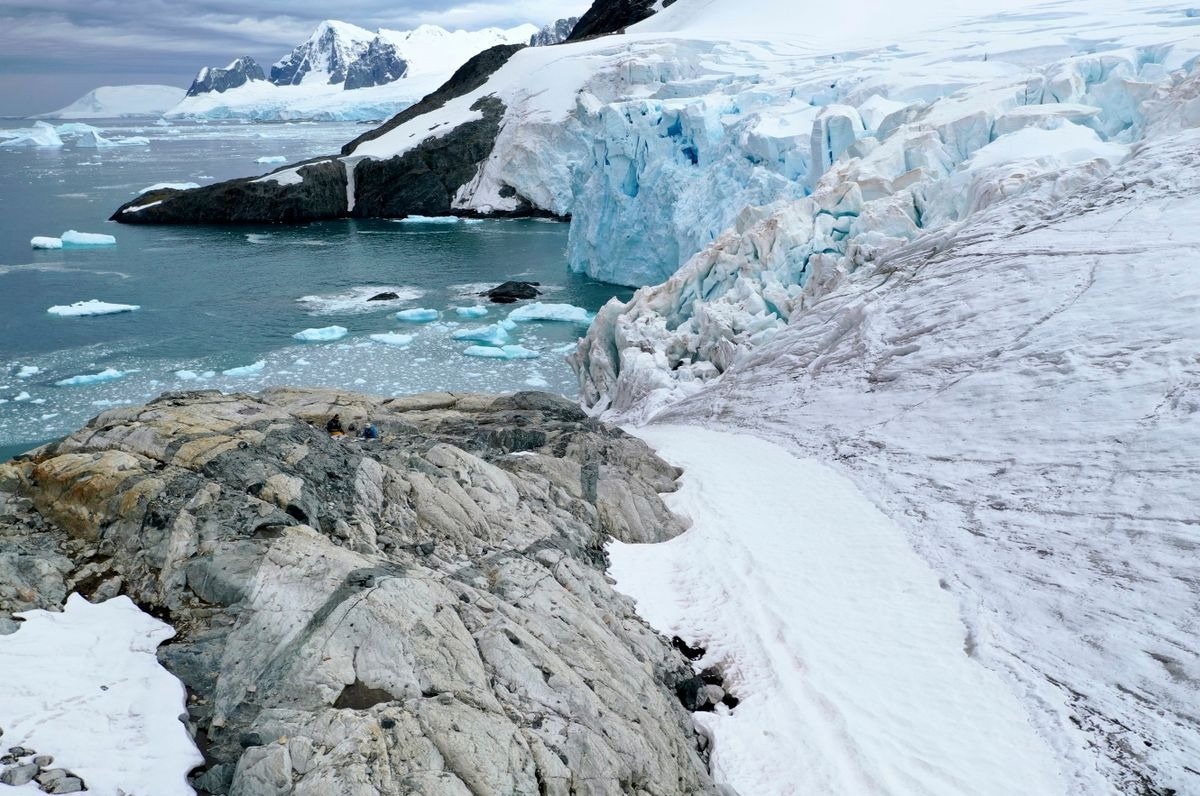A new study performed by West Virginia University mechanical and aerospace engineer Xi Yu could assist researchers in reaching ocean waters hidden away below ice shelves.

Retreating ice has exposed the rocky shoreline of Cape Rasmussen on the Antarctic Peninsula. Xi Yu, a West Virginia University engineer, is leading robotics research that could help a nationwide consortium of researchers learn more about glacial melt and changing levels of ocean ice. Image Credit: Derek Ford/University of Hawaii, Manoa
The hidden depths beneath the ice-covered oceans hold crucial information essential for comprehending the consequences of climate change. Yu is convinced that a fleet of marine robots, guided and organized by an intelligent mothership, can successfully reach these depths and relay their findings.
Yu, an Assistant Professor at the Benjamin M. Statler College of Engineering and Mineral Resources and a member of WVU Robotics, has secured funding from the National Science Foundation for a three-year project.
This project is dedicated to the development of technologies designed to control swarms of "passenger robots" that will be deployed by their autonomous mothership into the frigid depths of a subaquatic environment.
She is part of a nationwide network of oceanographers and engineers who have joined forces to address the pressing challenge of accessing oceanic ice cavities. This collaborative community, focused on developing a proof-of-concept mothership-and-passenger system, originated at Oregon State University and has grown to encompass computer engineers, roboticists, oceanographers, and glaciologists from institutions such as Brigham Young University, Temple University, Purdue University, the Woods Hole Oceanographic Institution, and WVU.
Hundreds of millions of people’s hometowns are threatened by rising global sea levels and the mass loss of glaciers is driving that rise.
Xi Yu, Assistant Professor, Mechanical and Aerospace Engineering, West Virginia University
Yu added, “What I have learned from the oceanographers and scientists is that glacier melts usually take place in under-ice cavities — the ice melts in those cavities, turning into fresh water. Then it flows out, driving ocean water into the cavities, which speeds up the melting of the ice shelves that stabilize the glacier.
“That’s why we want to observe what is going on in those cavities and help scientists better understand and predict glacier loss and sea level rise. With limited surface access to the cavities and a huge risk of losing any submarine that goes down to explore, we turned to this idea of an autonomous vessel carrying a robot crew,” continued Yu.
Yu mentioned that an exploration mission could demand anywhere between 10 and 100 passenger robots, functioning as a “coordinated communication network.” This robot swarm has the potential to collect samples from the ocean within ice shelf cavities, gathering crucial data for forecasting ice shelf melting, glacier stability, and the movement of ice into the ocean.
Oceanographers really need to get measurements from beneath the ice and it’s extremely difficult. I’ve heard stories about scientists drilling through kilometers of ice to try to reach these cavities. I want to help provide better options. When we came up with this idea, I was very excited from Day One.
Xi Yu, Assistant Professor, Mechanical and Aerospace Engineering, West Virginia University
While the primary objective of this research is to achieve under-ice observation, Yu expressed her conviction that the system under development possesses versatility beyond ocean ice exploration. She anticipates its potential for detecting and monitoring underwater algal blooms, as well as assessing conditions following disasters such as oil spills.
Yu’s expertise lies in orchestrating collaborative efforts among robots, which is why her research leadership primarily revolves around controlling passenger robots and facilitating seamless coordination within the robotic swarm.
The passenger robots share information about their positions and about the data they have collected. That information gets aggregated on the mothership to make sure no data is lost, that we can retrieve the robots, and that we have optimized the configuration of the swarm and the sampling the robots are doing.
Xi Yu, Assistant Professor, Mechanical and Aerospace Engineering, West Virginia University
Yu added, “We’re also working on swarm coordination algorithms that use the positions of the passenger robots relative to one another to optimize their navigation and their power consumption.”
According to Yu, the beliefs of cooperation and knowledge exchange that united scholars from various fields and institutions to explore the frigid depths played a pivotal role in the joint commitment to open-source the hardware, software, and communication algorithms, “so other researchers can adapt our system to their own mothership and swarm.”